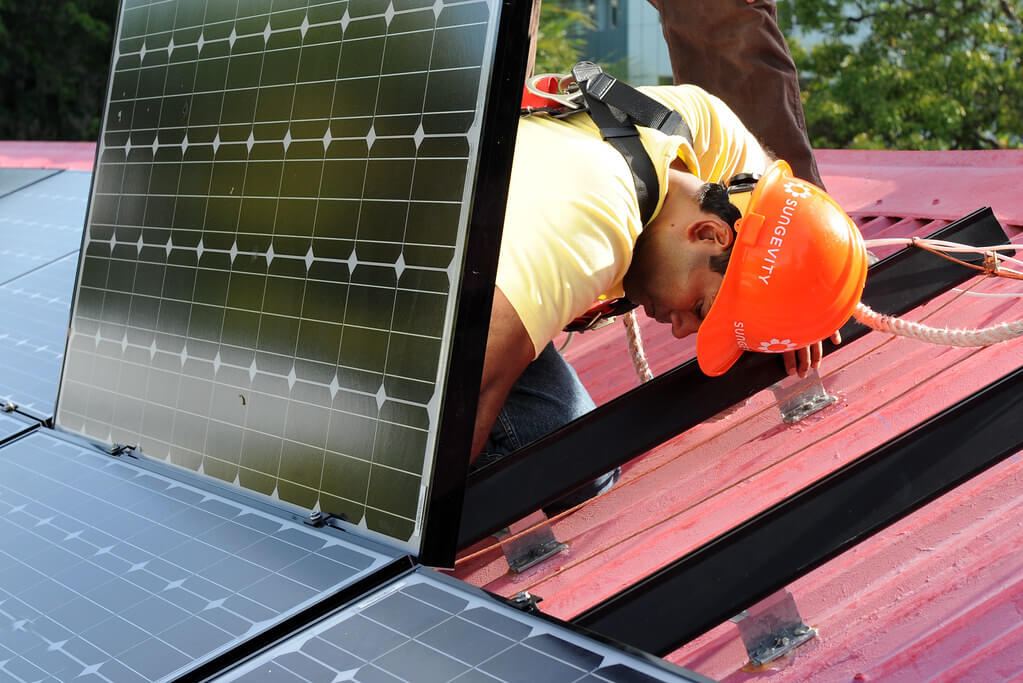
A Simple Guide to How Solar Panels Work (For Homeowners) in 2025
With solar energy powering over 7% of U.S. homes in 2025, residential solar panels are a popular way to slash electricity bills, reduce carbon footprints, and boost home value. The 30% Federal Solar Tax Credit, expiring for residential installations on December 31, 2025, makes now an ideal time to explore solar energy systems. But how do solar panels actually work? This beginner-friendly guide explains the process in simple terms, covering components, benefits, and costs to help homeowners make informed decisions. For personalized quotes, visit EnergySage to connect with trusted installers.
How Do Solar Panels Work? A Simple Explanation
Solar panels convert sunlight into electricity through a straightforward process. Here’s how it works, step by step:
- Solar Panels Capture Sunlight:
- What Happens: Solar panels, made of photovoltaic (PV) cells, absorb sunlight. Each cell contains silicon, which generates a small electric current when hit by photons (light particles).
- Key Component: Most panels use monocrystalline cells (19–22% efficiency) for higher output or polycrystalline cells (15–17%) for lower cost. A 7.2 kW system typically has 18–20 panels (400W each).
- Inverters Convert Electricity:
- What Happens: Solar panels produce direct current (DC) electricity, but homes use alternating current (AC). Inverters convert DC to AC for household use.
- Key Component: String inverters connect multiple panels (cost: $1,000–$2,000), while microinverters (one per panel, $100–$200 each) optimize performance in shaded areas.
- Electricity Powers Your Home:
- What Happens: Converted AC electricity flows to your home’s electrical panel, powering appliances, lights, and devices. Any excess energy can be stored or sent to the grid.
- Key Component: A net meter tracks energy sent to/received from the grid, reducing bills via net metering (credits for excess energy).
- Battery Storage (Optional):
- What Happens: Excess energy can be stored in a solar battery (e.g., Tesla Powerwall, 13.5 kWh) for use at night, during outages, or under time-of-use (TOU) rates, saving $500–$1,500/year in high-rate states.
- Key Component: Lithium-ion batteries (90–96% efficiency) cost $7,000–$18,000 but qualify for the Federal Solar Tax Credit.
- Grid Connection:
- What Happens: Most systems are grid-tied, using the utility grid as backup when solar production is low (e.g., at night or cloudy days). Net metering credits excess energy, lowering bills.
- Key Component: A Permission to Operate (PTO) from your utility ensures safe grid connection.
This process allows a 7.2 kW system to generate ~10,800 kWh/year in sunny states (e.g., California), covering most or all of an average household’s 10,632 kWh annual usage.
Benefits of Solar Panels for Homeowners
Installing solar energy systems offers significant advantages in 2025:
- Energy Savings: A 7.2 kW system saves $1,000–$3,500/year, depending on state electricity rates ($0.11–$0.33/kWh). Lifetime savings reach $31,000–$100,000 over 25 years, per EnergySage.
- Federal Solar Tax Credit: Saves 30% on installation costs (e.g., $6,600 on a $22,000 system) for systems installed by December 31, 2025. File IRS Form 5695 to claim it.
- Home Value Boost: Solar homes sell for 4–6.8% more ($15,000–$27,200 for a $400,000 home), per 2021 Zillow and 2019 LBNL studies.
- Environmental Impact: Cuts ~8,000 lbs of CO2 annually, equivalent to planting 120 trees, appealing to eco-conscious buyers.
- Energy Independence: Reduces reliance on rising utility rates (2–4% annually) and outages with battery storage.
Solar Panel Costs and Savings in 2025
Understanding solar panel costs helps homeowners weigh the investment:
- Average Cost: A 7.2 kW system costs $18,144–$26,424 ($2.52–$3.67/W), including panels, inverters, mounting, labor, and permitting, per EnergySage.
- After Tax Credit: The 30% Federal Solar Tax Credit reduces costs to $12,701–$18,497. State incentives (e.g., New York’s 25% tax credit, up to $5,000) can save more. Check DSIRE for local programs.
- Battery Costs: Adding a 10–13.5 kWh battery costs $7,000–$18,000, with tax credit savings of $2,100–$5,400.
- Payback Period: 4–10 years, faster in high-rate states (e.g., CA: $0.33/kWh, 4–6 years) than low-rate states (e.g., ID: $0.11/kWh, 8–12 years).
- Financing Options:
- Cash Purchase: Cheapest long-term ($12,701–$18,497 after tax credit).
- Solar Loans: Zero-down loans add 5.99–8% interest, increasing costs to $26,000–$31,000.
- Leases/PPAs: No upfront cost but miss tax credits; payments ($50–$150/month) may exceed savings.
For cost comparisons, contact trusted installers like Sunrun.
Key Considerations for Homeowners
Before installing solar panels, consider these factors to maximize solar energy savings:
- Roof Suitability: South-facing, unshaded roofs with 15–40° slopes maximize output. Complex roofs (steep, tiled) may add $500–$2,000 to installation costs.
- Energy Usage: Review utility bills to size your system. An average household (10,632 kWh/year) needs a 7.2 kW system; high-usage homes (>15,000 kWh) may need 10–12 kW.
- Incentives: Combine the Federal Solar Tax Credit with state rebates (e.g., California’s SGIP, $150/kWh for batteries) to cut costs by 30–50%. Check DSIRE.
- Battery Storage: Essential for outages or TOU rates, but adds $7,000–$18,000. Choose high-efficiency batteries like Tesla Powerwall 3 (90% efficiency, 13.5 kWh).
- Installer Quality: Work with NABCEP-certified installers to ensure efficiency and 25-year warranties. Compare 3–5 quotes on EnergySage to save 10–20% ($2,000–$4,000).
- Net Metering: Available in most states, it credits excess energy at retail rates (e.g., 1:1 in Arizona), reducing bills. Verify with your utility provider.
Common Misconceptions About Solar Panels
- “Solar Panels Don’t Work on Cloudy Days”: Panels generate 10–25% of normal output on cloudy days, and grid-tied systems use utility power as backup.
- “Solar Is Too Expensive”: After tax credits and incentives, net costs are $12,701–$18,497 for a 7.2 kW system, with paybacks in 4–10 years.
- “Panels Require Constant Maintenance”: Panels need cleaning every 6–12 months ($150–$300) and occasional inspections, with 25–30-year lifespans.
- “All Solar Systems Are the Same”: Monocrystalline panels (19–22% efficiency) outperform polycrystalline (15–17%), and inverter/battery choices impact performance.
FAQs About How Solar Panels Work in 2025
How much electricity do solar panels produce?
A 7.2 kW system generates ~10,800 kWh/year in sunny states (CA, AZ) or 8,600 kWh in cloudy states (WA, ME), covering most of an average household’s 10,632 kWh/year.
How much do solar panels cost in 2025?
A 7.2 kW system costs $18,144–$26,424 ($2.52–$3.67/W). After the 30% Federal Solar Tax Credit, costs drop to $12,701–$18,497.
Can solar panels power my home at night?
Yes, with a solar battery (e.g., 10–13.5 kWh, $7,000–$18,000) or grid connection via net metering. Batteries store daytime energy for nighttime use.
Do solar panels work during outages?
Grid-tied systems shut off during outages for safety unless paired with a battery (e.g., Tesla Powerwall 3, 13.5 kWh) for backup power (12–48 hours).
Is the Federal Solar Tax Credit still available?
Yes, the 30% tax credit applies to systems installed by December 31, 2025, saving $5,443–$7,927 on a $18,144–$26,424 system. It’s nonrefundable but rolls over.
Conclusion: Go Solar with Confidence in 2025
Solar panels work by converting sunlight into electricity through photovoltaic cells, inverters, and optional batteries, offering homeowners solar energy savings of $1,000–$3,500/year and a 4–6.8% home value boost. With solar panel costs at $12,701–$18,497 after the Federal Solar Tax Credit (expiring December 31, 2025), 2025 is the perfect year to invest in solar energy systems. Start by comparing quotes from trusted installers like Sunrun on EnergySage and check state incentives on DSIRE to maximize savings. Embrace clean energy, cut bills, and power your home sustainably!
